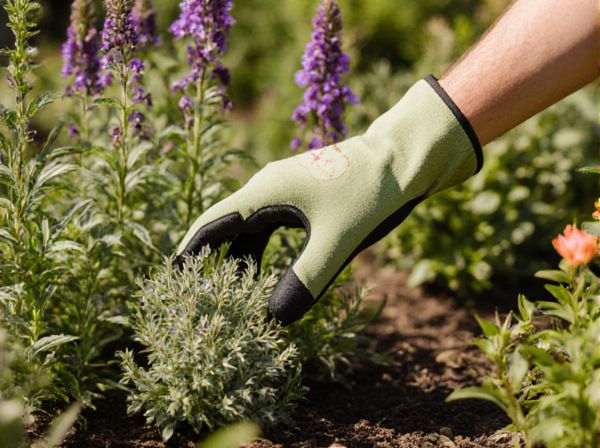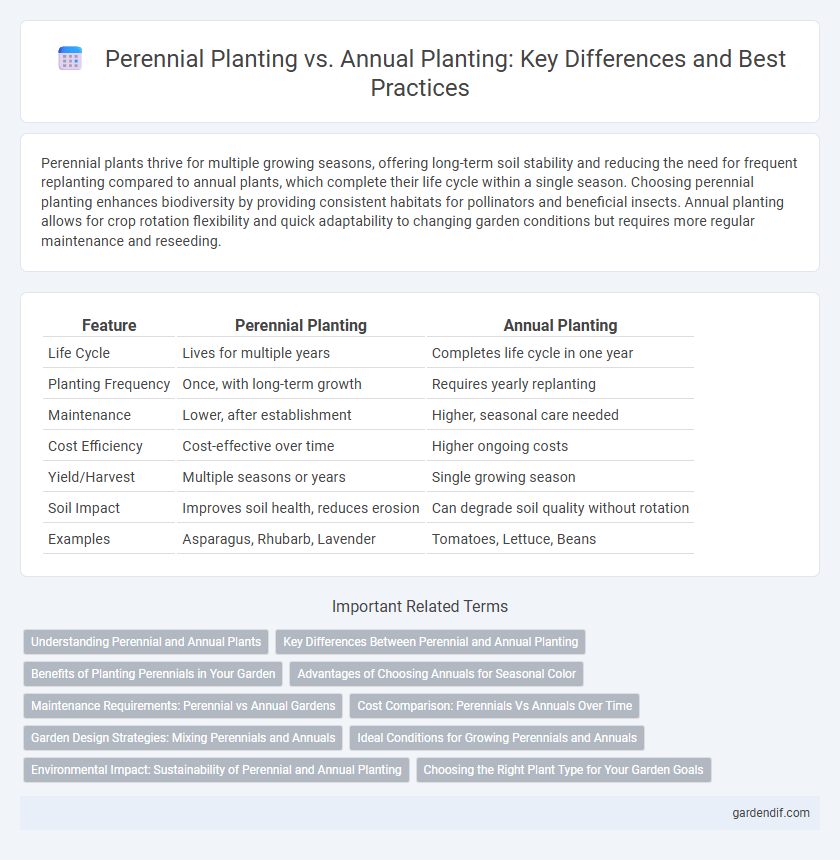
Perennial planting vs Annual planting Illustration
Perennial plants thrive for multiple growing seasons, offering long-term soil stability and reducing the need for frequent replanting compared to annual plants, which complete their life cycle within a single season. Choosing perennial planting enhances biodiversity by providing consistent habitats for pollinators and beneficial insects. Annual planting allows for crop rotation flexibility and quick adaptability to changing garden conditions but requires more regular maintenance and reseeding.
Table of Comparison
| Feature | Perennial Planting | Annual Planting |
|---|---|---|
| Life Cycle | Lives for multiple years | Completes life cycle in one year |
| Planting Frequency | Once, with long-term growth | Requires yearly replanting |
| Maintenance | Lower, after establishment | Higher, seasonal care needed |
| Cost Efficiency | Cost-effective over time | Higher ongoing costs |
| Yield/Harvest | Multiple seasons or years | Single growing season |
| Soil Impact | Improves soil health, reduces erosion | Can degrade soil quality without rotation |
| Examples | Asparagus, Rhubarb, Lavender | Tomatoes, Lettuce, Beans |
Understanding Perennial and Annual Plants
Perennial plants live for multiple years, often growing and blooming during their growing seasons without the need for replanting, making them ideal for long-term gardens and landscapes. Annual plants complete their entire life cycle--from germination to seed production--in one growing season, requiring replanting each year to maintain garden aesthetics or crop yields. Understanding the growth habits and lifecycle differences of perennials and annuals is essential for effective garden planning and sustainable planting strategies.
Key Differences Between Perennial and Annual Planting
Perennial planting involves plants that live for multiple growing seasons, developing deeper root systems and requiring less frequent replanting compared to annual planting, where plants complete their life cycle in a single season. Perennials often provide long-term stability and reduced soil erosion, while annuals offer seasonal variety and faster growth cycles. Choosing between perennial and annual planting depends on garden design goals, maintenance preferences, and climate resilience needs.
Benefits of Planting Perennials in Your Garden
Perennial plants offer long-term benefits by returning year after year, reducing the need for replanting and saving time and resources in your garden. Their deep root systems improve soil structure, enhance water retention, and promote biodiversity by providing consistent habitats for pollinators and beneficial insects. Choosing perennials supports sustainable gardening practices through lower maintenance and increased resilience to weather fluctuations.
Advantages of Choosing Annuals for Seasonal Color
Annual plants provide vibrant and continuous seasonal color by completing their life cycle within one growing season, allowing gardeners to experiment with a wide variety of species and colors each year. These plants quickly establish, bloom profusely, and can be replaced easily to match evolving landscape designs and climate conditions. The flexibility of annuals supports dynamic garden aesthetics and encourages biodiversity by attracting different pollinators throughout the seasons.
Maintenance Requirements: Perennial vs Annual Gardens
Perennial gardens typically demand lower maintenance as plants regrow each year without needing replanting, reducing labor and costs over time. Annual gardens require planting from seed or transplant annually, increasing time and effort for soil preparation, planting, and frequent watering. Perennials also often develop deeper root systems, enhancing drought resistance and reducing irrigation needs compared to annual counterparts.
Cost Comparison: Perennials Vs Annuals Over Time
Perennial plants typically require a higher initial investment but lower maintenance costs over multiple growing seasons compared to annuals, which need to be replanted each year, increasing long-term expenses. While annuals offer seasonal variety and quicker blooms, their recurring purchase and planting costs accumulate, making perennials more cost-effective over a multi-year period. Gardeners seeking budget-friendly options should consider perennials for sustainable landscaping with reduced repetitive spending.
Garden Design Strategies: Mixing Perennials and Annuals
In garden design strategies, mixing perennials and annuals enhances visual interest by combining the reliable structure of perennials with the vibrant, seasonal color of annuals. Perennials establish a stable framework that requires less frequent replanting, while annuals provide flexible design options to refresh the garden's appearance each year. Integrating both plant types maximizes bloom duration and supports biodiversity, creating dynamic landscapes that adapt to changing aesthetics and environmental conditions.
Ideal Conditions for Growing Perennials and Annuals
Perennials thrive best in well-drained soil with consistent moisture and ample sunlight, typically requiring a minimum of six hours of direct light daily to establish deep root systems for long-term growth. Annuals demand fertile, nutrient-rich soil and regular watering, favoring full sun exposure to complete their life cycle within a single growing season. Both plant types benefit from climate conditions suited to their native environments, with perennials often excelling in temperate zones and annuals adapting well to diverse, shorter growing periods.
Environmental Impact: Sustainability of Perennial and Annual Planting
Perennial planting significantly reduces soil erosion and improves carbon sequestration by maintaining continuous root systems year-round, enhancing soil health and biodiversity compared to annual planting. Annual planting often requires frequent tillage and replanting, which increases fuel consumption, greenhouse gas emissions, and soil degradation over time. Sustainable agriculture increasingly favors perennials for their ability to reduce environmental impacts and promote long-term ecosystem stability.
Choosing the Right Plant Type for Your Garden Goals
Perennial planting offers long-term garden stability by returning year after year with minimal replanting effort, making it ideal for low-maintenance landscapes and sustainable gardening. Annual planting provides vibrant seasonal interest and allows for flexibility in garden design, perfect for gardeners seeking frequent changes and colorful displays. Selecting the right plant type depends on your goals such as desired maintenance level, garden longevity, and aesthetic preferences.
Perennial planting vs Annual planting Infographic

 gardendif.com
gardendif.com